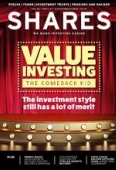Archived article
Please note that tax, investment, pension and ISA rules can change and the information and any views contained in this article may now be inaccurate.
High yielding trusts: are the rewards worth the risks?

Many investment trusts offer high yields which might tempt some investors in the current environment. But are they more trouble than they’re worth?
Some may be worth pursuing, while others can have complex investment models and come with underappreciated risks.
HOW MUCH CAN YOU GET?
Data from the Association of Investment Companies implies there are numerous investment trusts offering yields of 8% to 12% or even more, but the areas in which they invest are quite esoteric.
Doric Nimrod Air Two (DNA2) and Doric Nimrod Air Three (DNA3), for example, are trusts which buy aircraft and then lease them to airlines, while Tufton Oceanic Assets (SHIP) leases ships.
While investing in the Doric funds is really a binary bet on the survival of its main customer, state-owned airline Emirates, the Tufton fund has a more diversified portfolio of ships, although it has been affected by changing supply and demand and disrupted global trade due to Covid-19.
Miton fund manager Nick Greenwood owns Tufton in his portfolios, benefiting from its 8.6% yield. He says the assets have ‘residual value’ as scrap steel even if their value depreciates.
SPECIALITY FINANCE
Many high-yielding trusts borrow money to increase the pool of cash available to invest (known as ‘gearing’) and then use that money to invest in other people’s or companies’ debt. This web of involvement in the debt space may not appeal to risk-averse investors.
Volta Finance (VTA) is involved in corporate credit, mortgages, and auto and student loans, while Honeycomb (HONY) focuses on asset-backed consumer, property and small business loans.
Blackstone/GSO Loan Financing (BGLP) and Volta are among those trusts investing in collateralised loan obligations (CLOs), a single security backed by a pool of debt. Investors get geared exposure to leveraged loans which amplifies the risks.
Packaged loans played a key role in the events that caused the global financial crisis, so they will sound unpalatably risky for a lot of investors. But Sachin Saggar, an analyst at Stifel, says CLOs held up quite well throughout past crises.
‘If you look at how CLOs behaved in 2008, they actually came through quite well. They ultimately recovered all their losses plus more. But what you get with them is more volatility and risk.’
Greenwood at Miton says he is ‘nervous’ about some alternative lenders which have relatively new and untested business models. ‘Some of them seem to have run into problems lending money to people that decided they didn’t want to pay it back in benign conditions, so I wonder what’s going to happen in tougher conditions,’ he comments.
FURTHER USES OF GEARING
More mainstream trusts that offer high yields are Aberdeen Standard Equity Income (ASEI), Merchants Trust (MRCH) and Chelverton UK Dividend (SDV), in the UK Equity Income sector; and Acorn Income (AIF), in the UK Equity & Bond Income sector.
These trusts can pay high yields because of their use of gearing. Greenwood comments: ‘If a trust draws draw down some debt, they can actually pay out a much higher yield using the investment trust capital structure, but obviously that speeds up the rise or fall in the net asset value. You should always look at the leverage.’
HIGH YIELDS FROM PROPERTY
There are also property funds in the list of high-yielding trusts, such as Regional REIT (RGL), which was, until recently, yielding more than 11% through investing in commercial property such as offices and industrial building outside the M25.
Unfortunately, last month it reduced its quarterly dividend by 21% after adopting a more conservative approach during the pandemic. That still leaves it on an 8.9% yield based on guidance for dividends for the rest of the year and the ones already declared.
Real Estate Credit Investments (RECI), Starwood European Real Estate Finance (SWEF), and ICG-Longbow Senior Secured UK Property Debt Investments (LBOW) also feature among the highest-yielding trusts. They provide loans to commercial and residential assets at low loan-to-values.
Saggar notes it is currently hard to value property assets, so these trusts have traded down, however, he thinks their yields ‘seem relatively robust at this point’.
'NOT A FREE LUNCH'
So how reliable have these funds been in terms of the track record of their yields, and how sustainable are these sky-high payouts?
Some trusts suspended or reduced their dividend payments in Q1 but have since restarted them, explains Saggar.
In a recent note on CLO funds, Stifel said there were ‘good reasons’ for funds to amend their dividend policies, namely the impact of coronavirus, but that many were trying to sustain payouts. ‘We highlight Blackstone and Volta as being the most cognisant of shareholders’ desire to continue to receive an income,’ it said.
In July, Stifel said Doric Nimrod should be able to keep up 20%+ yields on its funds for longer than expected, despite an uncertain environment.
Payouts overall have been relatively stable across the sector, says Saggar, although discounts to net asset value have widened on some trusts.
‘There are some bargains to be had because people have got rather nervous about some of these very high-yielding trusts, so there are some discounts around,’ notes Greenwood. However, the reason for wider discounts is that investors perceive rising risk, and this is something to bear in mind when looking for high yields.
‘If something’s yielding 8%-plus, there’s a reason why and it’s not without risk. It’s not like it’s a free lunch,’ adds Saggar.
So does holding a high-yielding trust mean investors are signing up for a wild ride? Not necessarily.
‘There is an argument that the high yield will actually smooth the volatility in the share price,’ says Greenwood. ‘But when you get events like the global financial crisis and the Covid-19 crisis, you’re reminded that anything can happen in the short term.’
Important information:
These articles are provided by Shares magazine which is published by AJ Bell Media, a part of AJ Bell. Shares is not written by AJ Bell.
Shares is provided for your general information and use and is not a personal recommendation to invest. It is not intended to be relied upon by you in making or not making any investment decisions. The investments referred to in these articles will not be suitable for all investors. If in doubt please seek appropriate independent financial advice.
Investors acting on the information in these articles do so at their own risk and AJ Bell Media and its staff do not accept liability for losses suffered by investors as a result of their investment decisions.

 magazine
magazine









